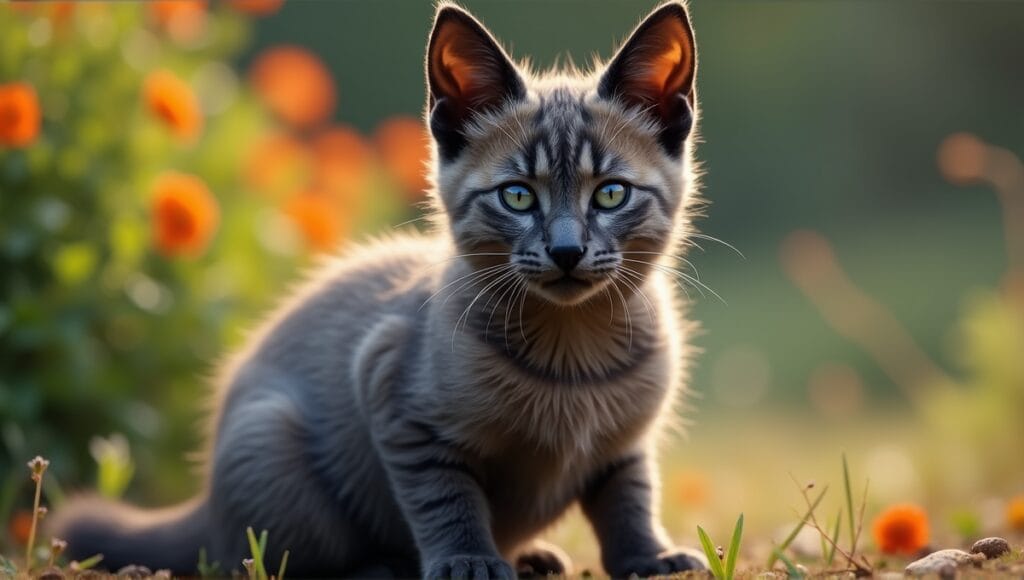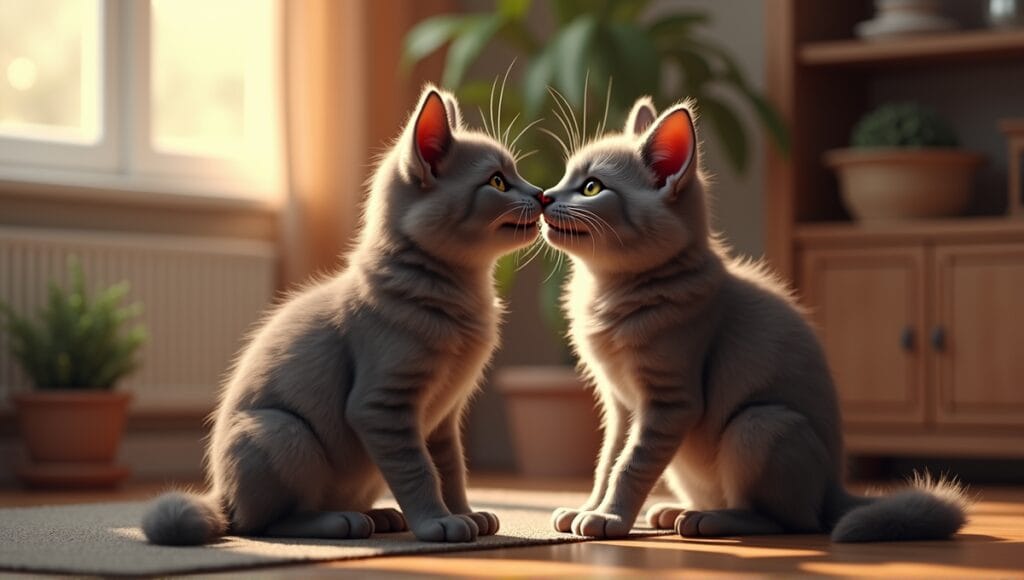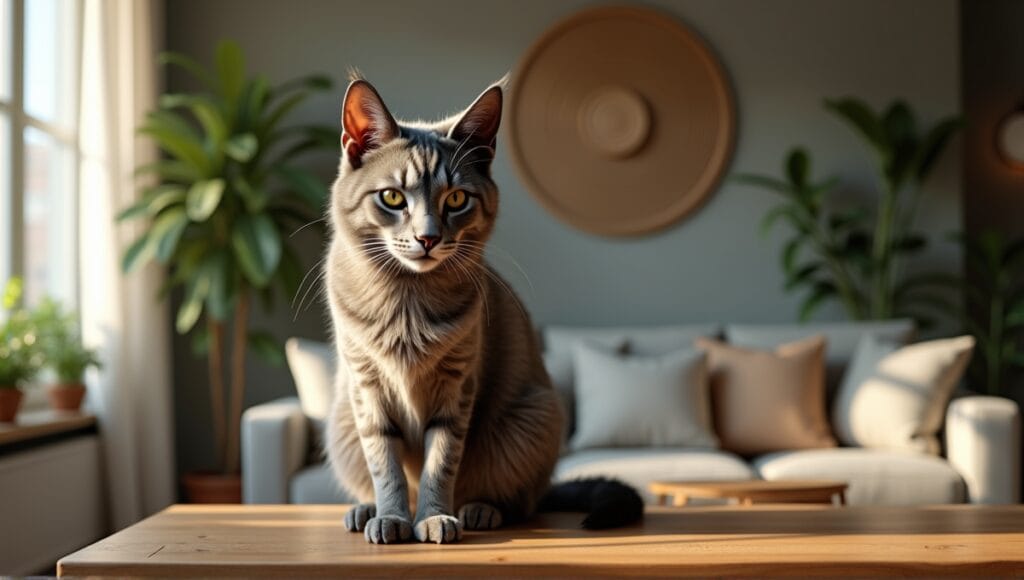I’ve been around the block as a cat lover, and I’ve never seen anything quite like Lykoi cats. These cats are capturing everyone’s attention due to their distinct appearance. They look like miniature werewolves thanks to their partially hairless fur and dramatic facial features. Discovered in 2010, Lykoi cats are the result of a natural genetic mutation. Unsurprisingly, they’re becoming more popular as people look for a unique pet.
Origins and Discovery of Lykoi Cats

Lykoi cats first made an appearance on the feline scene in 2010 when they were discovered within a population of feral cats due to a natural mutation. Cat breeders and enthusiasts quickly took notice of these cats, as they have a very unique appearance.
The first intentional breeding of Lykoi cats occurred in 2011 as breeders set out to create and refine the breed. Genetic testing and DNA analysis were key to unraveling the mystery of what these cats were. It was eventually confirmed that they were the result of a natural genetic mutation.
The breed was swiftly recognized by the wider cat community. The International Cat Association (TICA) granted the cats Registration Only status in 2012, which was a significant achievement for the cats. They achieved Championship status in 2016. The Cat Fanciers' Association (CFA) granted them registration status in 2018.
I've always been intrigued by the quick ascension of Lykoi cats in the cat fancy world. From being discovered in a feral population to becoming a fully recognized breed, it's quite the journey. It speaks to the commitment of the breeders and the unique allure of the cats themselves. Lykoi cats are just one of many exotic cat breeds that have gained popularity in recent years.
Unique Look of Werewolf Felines

Lykoi cats are truly unique in appearance with their partially hairless coat setting them apart from other breeds. You can immediately identify a Lykoi cat by their sparse coat. The sparse coat contributes to a wild, werewolf-like appearance, which is the origin of the nickname "werewolf cats."
The eyes of the Lykoi cat are one of the most captivating features. They're fairly large, round, and typically an amber or green color. Additionally, the ears of the Lykoi cat are another defining trait. They're quite large, pointed, and often tufted, further enhancing their wolf-like appearance.
There are only a few color variations of the Lykoi cat. The most common variation is black roan, which gives the cat a salt-and-pepper look. Some Lykoi cats have a solid black coat. While other colors are technically possible, they're exceptionally rare. If you're interested in other color variations, you might want to explore black cat breeds or white cat breeds.
The Lykoi cat has a particularly interesting molting pattern. It will shed its coat once or twice annually, and during this time, it may appear nearly bald. It's quite the sight to see! The coat then grows back in, resulting in the signature patchy appearance of the Lykoi cat.
I've encountered many Lykoi cats throughout my years working with different breeds, and I'm always amazed by their appearance. You simply can't take your eyes off their otherworldly allure, so it's no surprise they're becoming increasingly popular among cat enthusiasts.
Genetic Mutation Behind Lykoi Cats
The Lykoi cat's distinctive appearance is the result of a recessive gene that impacts hair growth and follicle development. It's a naturally occurring genetic mutation that arises spontaneously in feral cat populations.
In contrast, the genetic mutation that causes other hairless breeds is different. For example, Sphynx cats lack hair due to a distinct genetic mutation. The Lykoi gene allows for some hair growth, which produces the werewolf appearance.
Breeding Lykoi cats is challenging because both parents must carry the recessive gene to produce Lykoi offspring. Therefore, breeding true to type is difficult, and breeders may outcross with domestic shorthairs to maintain genetic diversity. This process is similar to cat breeding practices for other rare breeds.
I have a deep understanding of cat genetics, and the Lykoi mutation is particularly intriguing to me. It's a prime example of how natural genetic mutations can give rise to entirely new breeds of cats. When you see a Lykoi cat, you're essentially observing live evolution!
Lykoi Cat Temperament and Personality

Lykoi cats are very social. They love human interaction and are usually good with other pets. They'll often seek out your companionship and form strong attachments with their families.
They're also highly intelligent. Lykoi cats are great learners and enjoy interactive play. You can even train them to do tricks or play games like fetch. You'll be impressed by their ability to solve problems.
Lykoi cats have a moderate to high energy level. They enjoy playtime and exploring, so you'll need to invest in plenty of toys and activities to keep them happy. Interactive play is also essential to ensure they stay healthy.
Vocalization is a mixed bag with Lykoi cats. Some are more talkative than others, though most just have a quiet, pleasant meow. Their vocalizations are likely something you find charming about them.
Lykoi cats are also very adaptable to different environments. Whether you live in an apartment or a larger house, they make a great pet. As long as you give them attention and playtime, they're pretty low-maintenance. They're just an easygoing, flexible pet. In terms of temperament, they share some similarities with other friendly cat breeds.
Health Considerations for Lykoi Cats
Initial health testing of the founding Lykoi population revealed that they were relatively healthy cats. However, like any breed, continued monitoring is important.
There are no known breed-specific health problems with Lykoi cats. However, their lack of hair might make them more prone to skin issues. Check your cat's skin for any issues, and protect them from the sun since they can sunburn.
As for lifespan, you can expect Lykoi cats to live a similar length of time as other cats. With good care, they should live to be anywhere from 12 to 16 years old or older. You can help ensure this by taking your cat to the vet regularly. If you're curious about the lifespan of other hairless breeds, you might want to look into the hairless cat lifespan.
I always recommend preventive care as the best medicine. Schedule at least yearly vet visits for your Lykoi cat, keep them on a healthy diet, and make sure their vaccinations are current. These steps will help your cat live a long, healthy life.
Grooming Requirements for Werewolf Felines

Lykoi cats have unique skin care needs. Their partial hairlessness can lead to oily skin. Therefore, plan to wipe them down with a damp cloth regularly. This removes excess oil and keeps their skin healthy.
How often you should bathe your Lykoi cat depends on the individual cat. Some need monthly baths while others can go longer between baths. Use a gentle, cat-specific shampoo, and be sure to rinse them thoroughly. If you don't rinse all of the shampoo out, it can irritate their skin.
Lykoi cats also require regular nail trims. Since they don't have much fur, their nails are more noticeable, so you want to trim them every two to three weeks. Additionally, check their ears regularly and clean them as needed. Their ears are larger and can collect dirt.
All cats, including Lykoi cats, need good dental care. If you adopt a Lykoi, plan to brush their teeth. Daily brushing is best, but aim for at least two to three times per week. By doing so, you'll avoid gum disease and other dental issues.
I've groomed many cats throughout my career. While the Lykoi has some unique grooming needs, they're fairly low maintenance. As long as you establish a routine, you shouldn't find grooming your Lykoi to be too difficult. Their grooming requirements are quite different from long-haired cat breeds, which often require more intensive care.
Lykoi Cats' Dietary Requirements
Lykoi cats have the same nutritional requirements as any other domestic cat. Therefore, you'll want to provide a high-quality protein-rich diet. Look for cat food with meat listed as the first ingredient and avoid any with excessive fillers or by-products.
Feeding schedule: Stick to a feeding schedule. Most adult Lykoi cats do great on two meals per day. However, kittens may need to eat more frequently. Always defer to your veterinarian's feeding recommendations.
As for wet vs. dry food, choose based on your cat's preferences. Many cats do well on a mixture of both. Wet food will add some additional hydration, while dry kibble can help with dental health.
Water: Always ensure your Lykoi cat has access to fresh water. They may be more prone to dehydration due to their lack of fur, so clean water is a must. You may even want to consider a cat water fountain to entice them to drink more water.
Prevalence and Accessibility of Werewolf Felines

Lykoi cats are still relatively uncommon. The global population of show-quality Lykoi cats is probably less than 1000. Because of their rarity, Lykoi cats are in high demand among cat enthusiasts.
Locating a reputable breeder of Lykoi cats will require some research. Look for breeders that prioritize health and genetic testing. They should offer health guarantees and be open about the way they breed Lykoi cats.
Due to their rarity, you'll likely find yourself on a waitlist when searching for a Lykoi kitten. Their adoption process can be long, as demand often exceeds supply.
You can expect to pay a high price for a Lykoi cat. Because of their rarity and unusual appearance, breeders charge premium prices for Lykoi cats. Plan to spend between $1500 and $2500 on a pet-quality Lykoi kitten. You may find show-quality cats selling for even more.
I've guided many people through the process of adopting a cat over the years. If you're dead set on a Lykoi cat, be prepared to search for a while. However, remember that there are plenty of other fabulous cats in shelters. Consider all of your options when selecting a cat. If you're open to other breeds, you might want to explore rare cat breeds or mixed breed cats as alternatives.
Final Takeaways
If you think getting a college degree is the only way to build a good career, think again. You can learn the skills you need to start a high-paying job through online education platforms like Coursera, Udemy, and LinkedIn Learning. Some of the highest paying jobs only require specific skill sets rather than a traditional degree, such as computer programming and data analysis. Even if you don’t start your career with one of the highest paying jobs, many other jobs offer excellent growth opportunities if you’re willing to put in extra effort.






